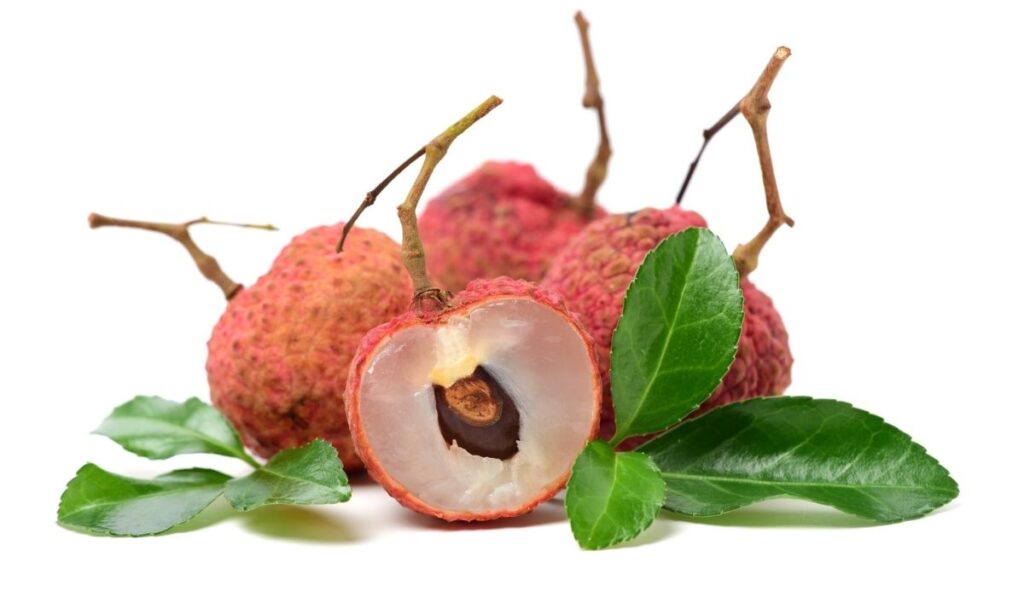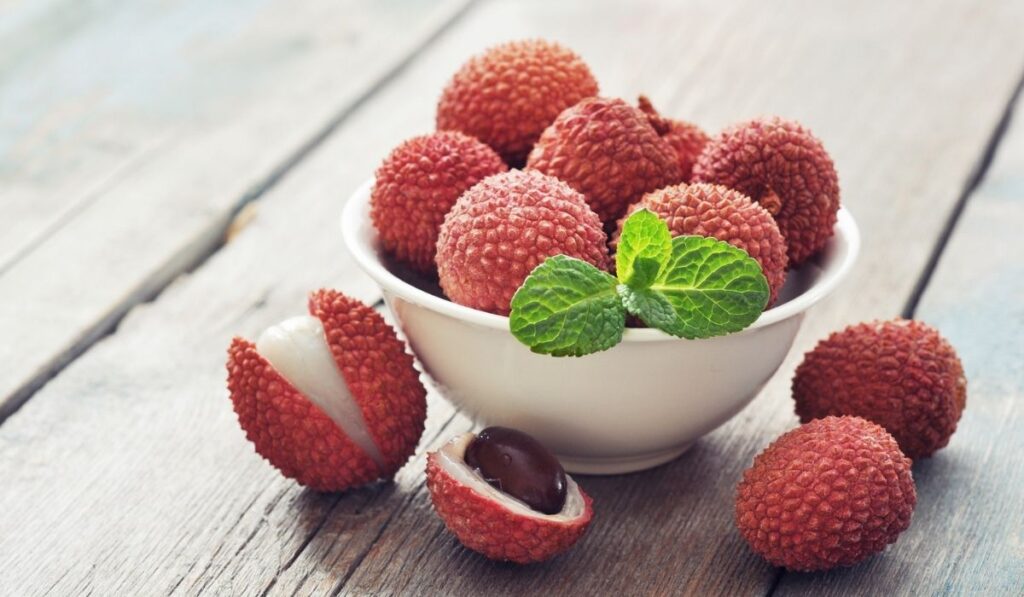Lychees are a unique fruit that looks like it came straight out of a fantasy book. The bumpy red exterior and pale white flesh make for an enticing fruit that’s hard to pass up. But when are these fruits available, and how do you enjoy them?
Fresh lychee is typically in season starting in May or June through September. You can enjoy lychee raw, cooked, blended, or in recipes. You can take off lychee skin like an orange peel and remove the seed (which is slightly toxic) as you would an avocado pit.
You’re in for a sweet treat if you’ve never enjoyed this unique fruit before. Here’s everything you need to know about lychee season and how to enjoy the fruit.
What Is Lychee?

Lychee, also known as litchi or alligator strawberry, is a native fruit of China. Lychees are a popular fruit in Asian countries and are grown in select parts of the United States. The fruit has a red, rough, and scaly rind with a light and fleshy interior that engulfs a large brown seed.
The rind of lychee is inedible, but the flesh has a sweet and floral flavor. You can buy lychees fresh, dried, or even canned. Lychees can be found in many desserts, drinks, ice creams, and other recipes across the globe.
When Is the Best Season for Lychee?
Although you can buy canned or preserved lychee all year round, fresh lychee has a taste like no other. The season for fresh lychee typically starts in May or June and ends in September. Some seasons might start in July, depending on the location.
If you find yourself outside of lychee season in your area, or you just can’t find any fresh lychee carried nearby, you can explore options like sun-dried lychee (on Amazon) or even lychee puree (also on Amazon) which can be added as an ingredient or flavoring to smoothies especially.
How Do You Eat a Lychee?
Lychee can be enjoyed in a variety of ways, whether it’s raw, cooked, or blended. One of the best ways to enjoy fresh lychee is by eating it raw. You can snack on the raw fruit or use it to complement cheese or wine.
Fresh lychee can also be added to garden salads or enjoyed along with other fruits. You can pair lychee with coconut, mango, banana, or even pineapple. Try adding lychee to a garden salad with slivered almonds and a light vinaigrette.
You might find lychee in sweet sauces or savory dishes throughout Asian cuisine. Lychee can be added to stir-frys to create a sweet and sour flavor. Or you can pair the fruit with chicken, fish, or even pork by making a homemade barbecue sauce.
Adding lychee to a dessert or smoothie is another popular way to enjoy the fruit. You can blend lychee into your morning smoothie or use it as a topping on ice cream.
Some people use the fruit to create a sweet syrup that can be used to lighten cocktails, teas, or other desserts. You can also find ready-made lychee syrup (on Amazon).
If you’re looking to enjoy lychees in the off season, try Four Elephants Premium Lychees (on Amazon), which are already peeled and pitted for convenient use.
How Do You Select a Lychee?
Whether you’re shopping at your local market or picking the fruit yourself, finding the perfect lychee is crucial to unlocking the best flavors. The fruit doesn’t ripen after it’s been picked from the tree, meaning you need to choose the freshest variety and use it within a week.
Look for fruits that are larger than one inch and have bright, vibrant skin. Typically, the rind of lychee is red, but you might find some with orange, yellow, or pink hues.
You can gently press the rind of the fruit with your thumb to check for ripeness. The fruit should give in slightly to pressure. The fruit might be too ripe if it’s too soft, however. You should also notice a full and floral smell. Avoid lychees with brown rinds, cracked skins, fermented scents, or dripping liquids.
How Do You Peel a Lychee?
You’ll need to peel lychee and remove the seed to enjoy the fruit. Lychee seeds are slightly poisonous, meaning only the pale flesh is edible. The fruit is delicate, so it’s important to be gentle.
You don’t need to wash lychee before or after removing the husk, as it protects the flesh inside. Here’s how to peel a fresh lychee fruit:
- Over a bowl, hold the lychee fruit in your fingers and pierce through the skin with your thumbnail.
- Peel back the rind like an orange. The skin should come off smoothly in a few pieces if the lychee is ripe.
- You’ll notice the exposed white flesh. If the flesh is transparent, has spotty areas, or has any off coloring, the lychee is starting to ferment and shouldn’t be consumed.
- Using a paring knife, gently score and cut the white flesh along one side to reveal the seed. Imagine the lychee as a miniature avocado.
- Open the scored lychee fruit. Use your fingers to gently pinch and dig under the seed to remove it. Don’t panic if the flesh gets a bit torn in the process.
- You’ll notice a small, light brown membrane inside the flesh of the lychee. This membrane was part of the pit and is completely edible. There’s no need to remove this part as you’ll lose too much juice and flesh in the process.
- Place the lychee in your bowl and enjoy!
Should You Refrigerate Lychee?

You should refrigerate fresh lychee as soon as you get home. Unlike other fruits, lychees don’t ripen after they’ve been picked, so there’s no reason to leave them out on the counter.
Fresh lychees should last anywhere from 5 to 7 days in the fridge, whether they’ve been peeled or not. Be sure to keep them in a resealable plastic bag or airtight container to retain moisture.
You can also freeze lychee to preserve them for longer. You can seal the unpeeled fruit in a freezer bag. Keep in mind that the skin might lose its color while in the freezer, but that won’t affect the flesh.
Frozen lychees can last up to 6 months but will start losing their flavor after that. You can enjoy frozen lychees on their own.
